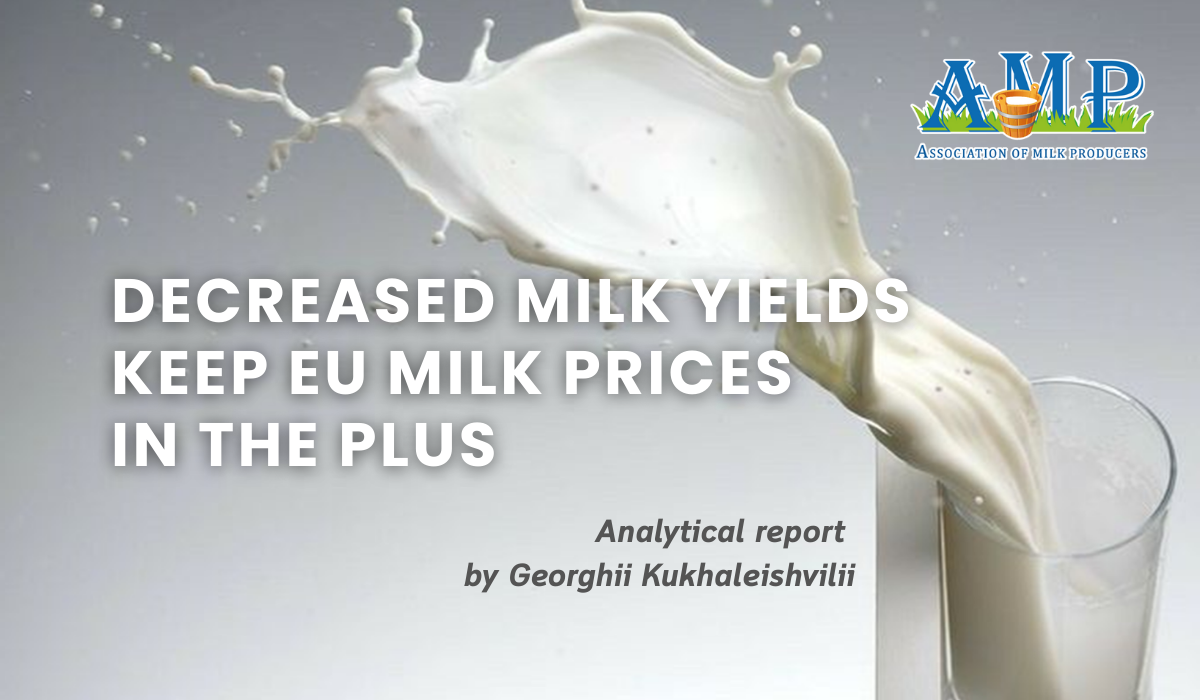The positive trend in raw milk prices in the EU continues, driven by reduced milk yields in several countries. However, slowing global butter prices and mixed export demand for milk powder are holding back a more significant increase in raw material costs, reports Georghii Kukhaleishvili, an analyst at the Association of Milk Producers.
According to preliminary data from the European Commission, in July 2025, the average price for raw milk in the EU was 53.17 euro cents per kg, which is 0.5% higher than in June 2025. Compared to July 2024, the price of milk in the EU increased by 14%. In July, the price of extra-grade milk in Ukraine was 37.18 euro cents per kg.
Compared to June, the price of raw milk increased in 12 EU member states. Among large producers and exporters of dairy products, raw material prices increased in France to 49.72 euro cents per kg (+1.7%) and in Poland to 53.38 euro cents per kg (+0.5%) compared to June 2025. The largest increases were seen in Belgium, where the price rose to 56.75 euro cents per kg (+7.5%), and in Slovenia, to 50.90 euro cents per kg (+4.2%).
In July, purchase prices remained unchanged in Germany, Denmark, Ireland, Spain, Italy, the Netherlands, Portugal, and Cyprus compared to June of the current year.
Over the past month, raw milk prices decreased in 6 countries. The largest price reductions were observed in Slovakia to 44.94 euro cents per kg (-8.2%), Lithuania to 48.04 euro cents per kg (-3.9%), and Estonia to 49.03 euro cents per kg (-3.4%).
The most expensive raw milk is in Cyprus (65.70 euro cents per kg) and Malta (61.90 euro cents per kg). The lowest prices for milk are received by farmers in Romania (41.02 euro cents per kg) and Slovakia (44.94 euro cents per kg).
Compared to July 2024, raw milk prices increased in 25 European countries. Relative to the same period last year, milk became most expensive in Sweden (+30%), Lithuania (+29.8%), and Belgium (-29.4%). The price decreased only in Romania (-0.8%) compared to the previous year.
Georghii Kukhaleishvili suggests that the moderate growth in raw milk prices in the EU is due to a reduction in raw milk production in several European countries. According to Teagasc, milk yields decreased in major milk producers like Germany and the Netherlands in 2025. However, according to preliminary USDA data, the decline in milk production in Europe in July 2025 was smaller than in July 2024. Milk yields remained stable in France and Spain and increased in Ireland and Poland.
A more significant increase in European purchase prices is likely not happening due to a weakening of global butter prices, as evidenced by the results of the recent 385th GDT auction. Demand for raw milk from milk powder producers is also decreasing. Compared to 2024, the EU has increased its production of cheese and whey, but the production of skim milk powder and whole milk powder has decreased amid unfavorable market conditions. As reported by Agriland, demand for dairy products in the first half of 2025 was positive, driven by increased shipments to the Middle East and Southeast Asia, despite a decline in import volumes from China. China traditionally bought large volumes of whole milk powder, but in May 2025, the country reduced its imports by 13% compared to last year.
On the other hand, the USDA suggests an increase in demand for whole milk powder from China due to the growth of the urban population, an increase in citizens' purchasing power, and greater consumption of proteins and dairy products. The growth in consumption of powdered milk formulas could be supported by the Chinese government's introduction of a state subsidy system for childcare as part of the country's efforts to support families and stimulate the birth rate. In turn, this could contribute to a rise in global prices for whole milk powder and boost demand for raw materials in exporting countries.
Press Service of the Association of Milk Producers
Follow us on Facebook
Related News


